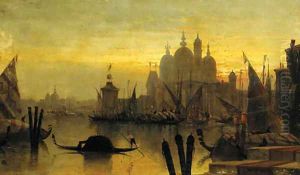Karl Kauffmann Paintings
Karl Kauffmann, also known as Carl Kauffmann, was an Austrian artist known for his historical and religious paintings, as well as for his work as a muralist. Born on April 28, 1843, in Vienna, Austria, Kauffmann was part of the Austro-Hungarian Empire during a period of significant cultural and artistic development. He pursued his artistic education at the Academy of Fine Arts Vienna, one of the most prestigious art schools in Europe, where he was influenced by the academic art tradition of the 19th century.
Kauffmann's style was characterized by a strong adherence to realism and a detailed approach to his subjects. His works often depicted scenes from history, mythology, and the Bible, rendered with a meticulous attention to detail and a sense of drama. Kauffmann was also known for his landscape paintings, which typically conveyed a romantic sensibility that was common among many artists of his time.
Throughout his career, Kauffmann received various commissions for public and private works, including frescoes and altarpieces for churches. His murals can be found decorating the walls of notable buildings in Austria, and his religious works often reflect the piety and devotional practices of the era.
Kauffmann's work was well received during his lifetime, and he participated in numerous exhibitions, earning accolades and recognition for his contributions to Austrian art. He remained active as an artist until his later years, continuing to produce works that adhered to the academic standards of his training.
Karl Kauffmann passed away on October 4, 1905, in Vienna. While Kauffmann may not be as widely known today as some of his contemporaries, his work represents an important part of the rich tapestry of 19th-century European art. His paintings continue to be of interest to collectors and historians who specialize in the period and are held in various collections and museums in Austria and beyond.
